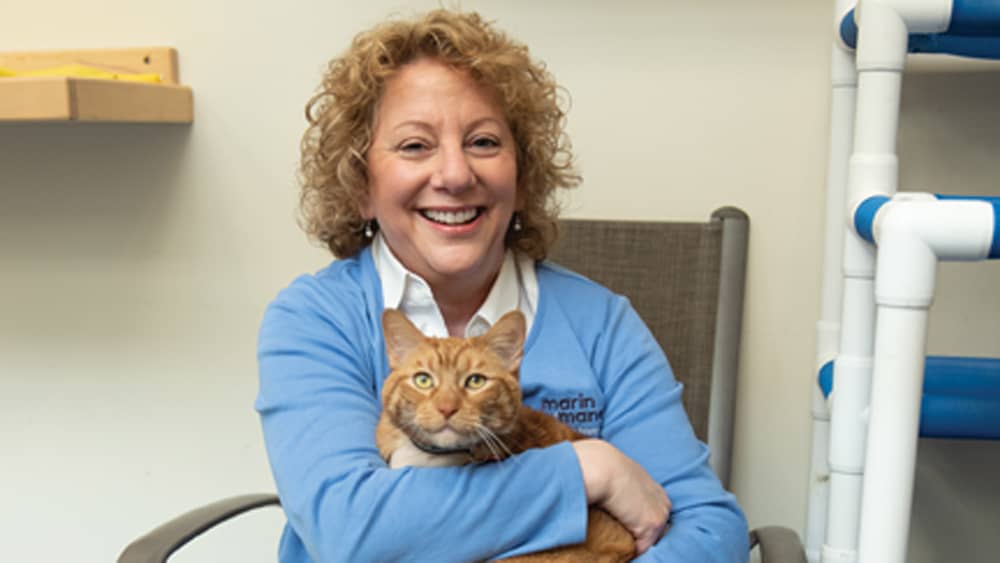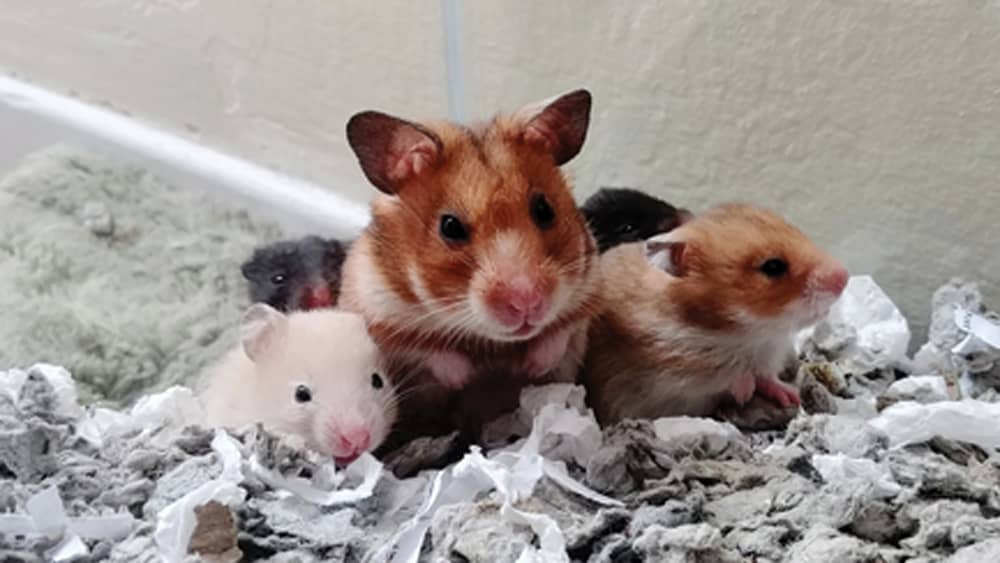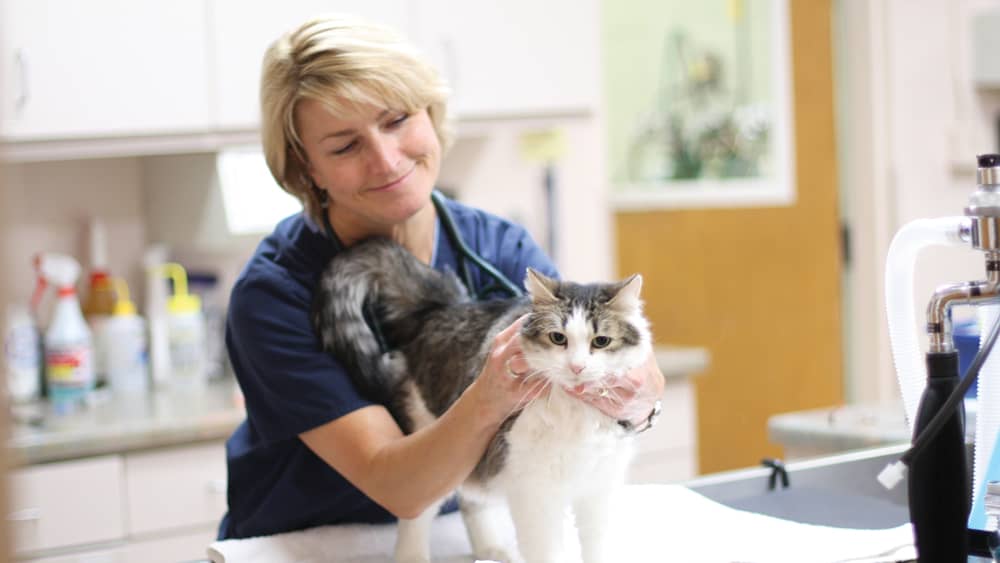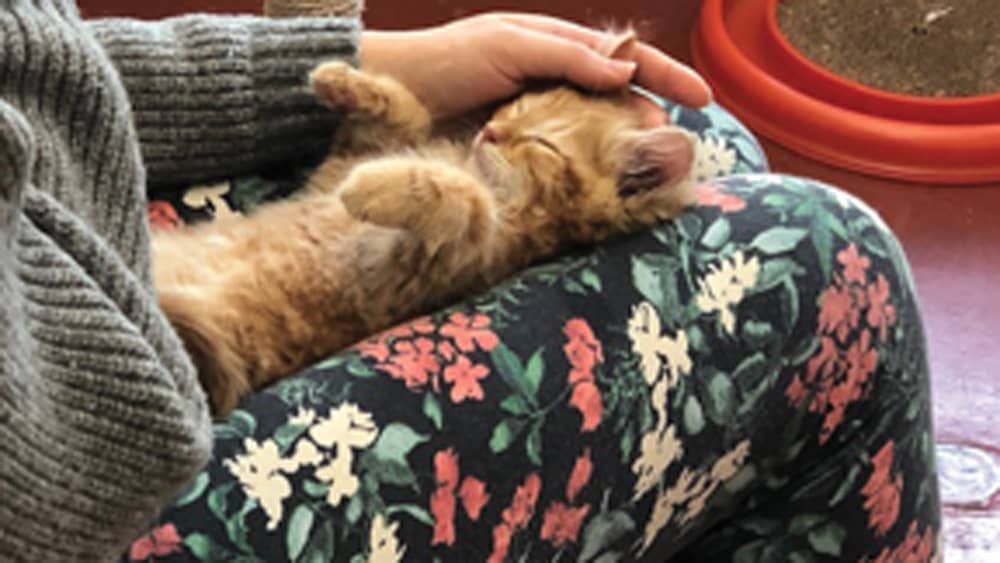
The silver lining in the ominous cloud of the pandemic may be covered in pet hair.
As with board games, puzzles, musical instruments, books, cooking shows, and ah yes, paper goods, the demand for pet adoptions has grown markedly since the shelter-in-place mandates began last March. The continued presence of wagging tails alongside their humans and sleeping felines behind sun-lit windows is thanks to the undaunted strength of local pet shelters and rescues.
A new business model
Last spring, with little notice, shelters collectively evolved into a “disaster model” of doing business that, ironically, is making significant improvements on how pets are adopted. “National conversations—through virtual meetings among shelters—began as shelters across the country closed,” says Nancy McKenney, CEO of Marin Humane. “We began weekly check-in calls to share thoughts and provide a support system for each other. We’ve learned a lot and shared a lot. The creativity of inventing new best practices is exciting. The positives outweigh the negatives. It’s a good way for us to figure out who needs help, and it allows us to be viewed as a support system for pets. Also, taking on the new lens of protecting staff, keeping them informed, and keeping them healthy is a bigger weight on our shoulders.”

Humane Society of Sonoma County (HSSC) adopted out more than 900 pets between March and November of last year. Ironically, the numbers of adoptions are slightly lower than those from previous years. “We were actually concerned we were going to be a lot less when pandemic restrictions first began,” says Karrie Stewart, manager of HSSC’s Healdsburg campus. “There have been more adoptions, but we had a pause in the spring because we had to close at the beginning of the shelter-in-place order. We pivoted our operations for safety and social distancing with new protocols, including the ‘adoptions by appointment’ model. We saw an increase in adoptions from May through October, and July was a big month. They go very quickly. Fortunately, we tend to have more interested adopters than animals come in.”
McKenney says a PPP loan kept her staff whole until mid-July when she had to cut back some hours and unfortunately, two employees. “The community has been generous in offering contributions. We usually get the bulk of contributions at the end of the year. Animal adoptions have gone down 14 percent more this year than last. We don’t have as many animals as we usually do when we’re open. But, it wasn’t as bad as we thought,” she says.
Most animals taken to shelters are dogs—many don’t take healthy cats since they are self-sufficient and find homes on their own, but an occasional rabbit or even a rooster might appear on a shelter doorstep. Although animal rescues across the country saw a spike in adoptions and foster applications in the beginning months of the pandemic, the real problem lies in the difficulty of social distancing restrictions. Volunteers now must make appointments to help. Vaccines, spay and neuter programs and nonessential vet appointments are restricted, threatening rescue operations and the lives they are trying to save.
Nonprofit organizations do so much for the communities that they’re often first to feel the effects of a struggling economy. And animal shelters do a lot more than find homes for lost pets. “Animal shelters are not just shelters. It’s about keeping pet owners and animals together with humane education and support,” says McKenney. While performing life-saving efforts for the sick and injured, spay and neuter clinics help keep animal overpopulation at bay. Many shelters have pet pantries to help feed animals, and they educate children through camps and provide personal pet-support training. The challenge of working with limited municipal and county budgets and relying on donations is overwhelming. Rescues recoup the cost of vet visits, care, and food through adoption fees, donations and fundraisers, but finances for many are tight. Benefit events are mostly virtual, which helps, but doesn’t compare to the income raised through in-person galas and other events.

A virtual, personal touch
Traditionally, shelters opened their doors to potential adopters who selected pets on the spot. Shelter adoptions are now available online or by appointment only. Most begin with an online application. After the review of applications, phone calls, FaceTime or Zoom meetings follow, with finally, a virtual or scheduled outside appointment for meeting potential pets. Usually, the paperwork is completed remotely, including payment for the adoption fee. Some offer curbside pickup, while others require safety protocols to minimize interactions with staff. Today, pet adoptions are a custom-tailored matchmaking process rather than a simple shelter walk-through.
The process is also more personal because it allows shelter caregivers time to delve deeper and learn more about adopters’ needs. The result is the dwindling numbers of animals returning to shelters. “The online process does take longer, but spur-of-the-moment adoptions can sometimes have bad results. An all-day public showing is difficult on the animals, who sit patiently in cages waiting for attention, especially those who tend to be ignored,” says Mickey Zeldes, shelter supervisor at the Rohnert Park location. “We figured out how to do adoptions as personally as possible using Zoom and FaceTime. We are getting such great feedback on our new approach. It gives our adoption staff much more time to spend with people, and we want to keep that going.”
HSSC locations in Santa Rosa and Healdsburg are seeing positive results from virtual adoptions, as well. “In the past, someone may fall in love with an animal in the shelter just by looking at them, and then might find out the pet isn’t a good match for their home when they speak with an adoption counselor. We’re filtering through better matches now because of the virtual meetings and conversations and seeing a low return rate,” says Stewart. “We try to help out area shelters when we can. For example, a group of healthy cats from Solano came and all of them were adopted. We partner back and forth with our Santa Rosa location for medical care and assistance with behavior needs.”
Napa County’s shelter is small. Typically, volunteers walk in to help, but now they call ahead to schedule. “This has cut down on the number of people who come,” says Kelly Tracey, a 33-year veteran and shelter supervisor at Napa County Animal Shelter. “Everything by appointment is so much easier than having doors open on a Saturday morning and having 35 people walk in at once.”
Fostering as an alternative
Volunteers who offer their homes and hearts to homeless animals provide opportunities for dogs, cats, puppies and kittens that allow them to receive loving care and heal from unhealthy or abusive situations. People who foster may parent injured animals recovering from surgery, animals of advanced age or dogs that need socialization and training. The support of nurturing homes for animals waiting for adoption makes a big difference.
“We don’t have a lot of space for many people to be here at once,” says Tracey. “Fostering out kittens is not tough at all. We also fostered out a lot of our dogs in the beginning. The homes had more information about the dogs’ personalities and characteristics since they interacted with them personally. A family who keeps the dog they are fostering is known as ‘Foster Failure,’ but to me, they are really ‘foster successes.’ Hopefully, we will continue these trends into the future.”
Social media to the rescue
As animal organizations continue their life-saving work, many are turning to social media for help. But this isn’t new. According to the ASCPA, social media for animal awareness has been on the rise since 2018. Communication tools such as Facebook, Instagram and Twitter helped generate increased public support, making it possible for animals in need to have a better life.
“Fire season in the Bay Area displaced a multitude of animals, both large and small. Social media has been a godsend for us,” says Tracey. “Stray animals with no microchip or identification tag have been identified on [Facebook’s] Napa Valley Lost Pets and Missing Pets of Napa Valley. We have been posting pictures of animals to reunite pets with their owners. And owners who lost homes may shelter their pets with access to visiting rights.”
The Nextdoor app and website (nextdoor.com) allows neighborhood residents to post notices about lost pets and has been a valuable tool as shelters operate with limited resources. Subscribers connect to everyone nearby, and whether you need to find a lost pet or report finding one, reaching out to neighbors is instantaneous. “In the communities and neighborhoods, we are suggesting that if someone finds a stray animal, hang on to him or her if you can. Then, check for lost signs and local postings, such as Nextdoor,” says McKenney. “We have found that Nextdoor has helped immensely because, most likely, these animals are literally down the street from where they are lost.”
Giving up a pet is a traumatic experience for both sides of a symbiotic pet relationship. Unfortunately, life changes, and some face the heartbreak of rehoming pets due to financial stress, relocation or illness. Although the best way to rehome a pet is through family and personal connections, pet pictures and profiles can be posted on webpages such as Rehome by Adopt-A-Pet (rehome.adoptapet.com) and How I Met My Dog (howimetmydog.com). Applicants fill out online questionnaires, allowing the owners to find perfect matches for their pets. Many shelter websites offer rehoming services as well.

Humane education
“Interest for virtual dog training classes has spiked since people are staying home more and want well-behaved pets,” says McKenney. “New pet owners who need guidance and pets in need of sharpening some skills are keeping shelters busy, and many are hiring more trainers to fulfill the increased demands of training requests.”
Animal welfare camps for children are usually prevalent in the summertime and during school holidays. “We had to cancel our in-person camp, which had 300 registered. We were sad about that because camp brings the kids on campus, and they bring their parents to adopt,” McKenney says. “Kids do well with our camps. They come back to volunteer or even work for us as adults. Fortunately, we were able to offer the camps in a virtual format instead. It’s essential to teach the importance of animal welfare, not just care for dogs and cats. We wanted proof of the benefits, so we asked Dominican University’s psychology department to administer pre-and post-surveys to our campers. They use a rigorous assessment that proves the fact that empathy levels do go up. They’re publishing a paper and results this year.”
Puppy-and-dog training calendars are available on local shelter websites, including puppy classes and basic manners. Training and education classes are abundant in the North Bay, and the Humane Society offers more than just obedience school. A cat behavior webinar sold out in October in Marin County, with people as far away as New York attending. Whole group training is limited to small numbers, and evening and weekend classes are available for those who work on weekdays. “We have an animal-assisted therapy program. We have certified teams who partner with community organizations to bring the therapeutic effect of animals to those in need. They visit schools, assisted living communities, senior communities and other organizations,” says Stewart.
Safety nets for the community
Right now, making ends meet can be challenging. Both HSSC facilities offer community pet-food pantries to help address the issue. “We’re always welcoming donations for that,” says Stewart. “We package the food into smaller, more manageable bags, and it goes right back out into the community for pet owners in need.”
Additionally, many community veterinary clinics provide emergency pet services for people with limited incomes. Some offer low-cost spay-and-neuter services. Santa Rosa’s community veterinary clinic provides life-saving services for pet owners on a sliding scale, low-income qualifying basis. “This is still available to the public, and we always appreciate donations,” Stewart says. “The clinic is always booked but does its best to make time for life-saving situations, such as a broken limb or an emergency surgery.”
Vaccines tend to go by the wayside in turbulent times, and the Humane Societies in all three North Bay counties offer services to those with limited incomes, or for those who are experiencing financial stress. Veterinarians offer general exams and administer parvo, distemper and other necessary vaccines. Spaying and neutering services help keep animal populations down.
“We have a big concern for all of the renters who haven’t gone back to work. With the rent moratorium, some people will owe almost a year’s worth of rent,” Tracey says. “Our goal is to help people keep their pets and their homes. We’ve been giving out food, collars, leashes, food bowls and donated medical supplies such as flea treatments.”

Research suggests that senior citizens who own pets visit the doctor less, use less medication and have lower blood pressure. Having a pet helps get them out of the house, exercise and socialize with neighbors. “We know many seniors cannot the afford the high costs of veterinary care for their pets, and we are so pleased that our nonprofit, Animal Shelter League, is able to assist with that for low-income seniors living in Rohnert Park and Cotati” says Zeldes. “Silver Paws for Love is a separate program by the Paws for Love Foundation to help seniors adopt a pet—covering the adoption fee for seniors 55 and older who adopt a pet six years and older from Sonoma County Animal Services, Green Dog Rescue Project, Rohnert Park Animal Services or Forgotten Felines.”
A happy, healthy bond
All shelters want to cut down on the rehoming process for the welfare of pets and short-staffed rescues, according to Stewart. “The overarching theme is to strive to be the community’s safety net and keep pets safe, healthy and happy.” Regardless of budget restrictions and lack of staffing, North Bay shelters relentlessly provide homeless animals with care and protection while shielding our residents from dangers like bites and zoonotic diseases. They continue to educate and to support those in need. But, most importantly, they bond us with the unconditional love and the happiness that comes from owning a pet.



